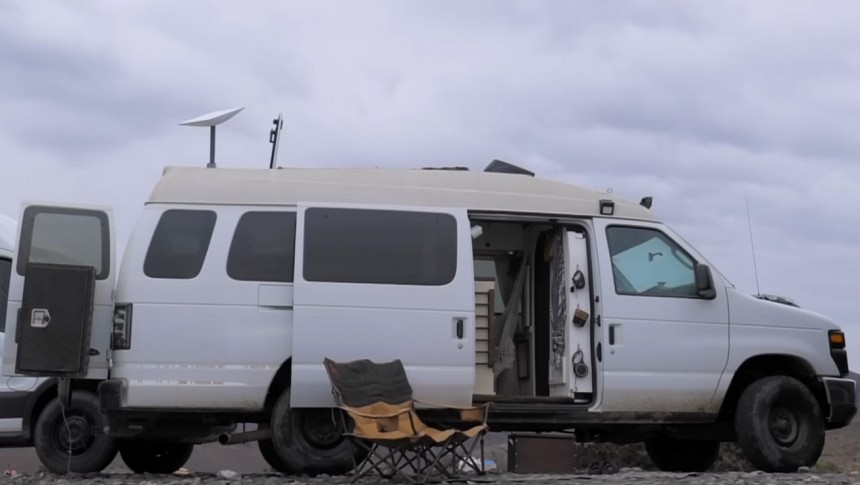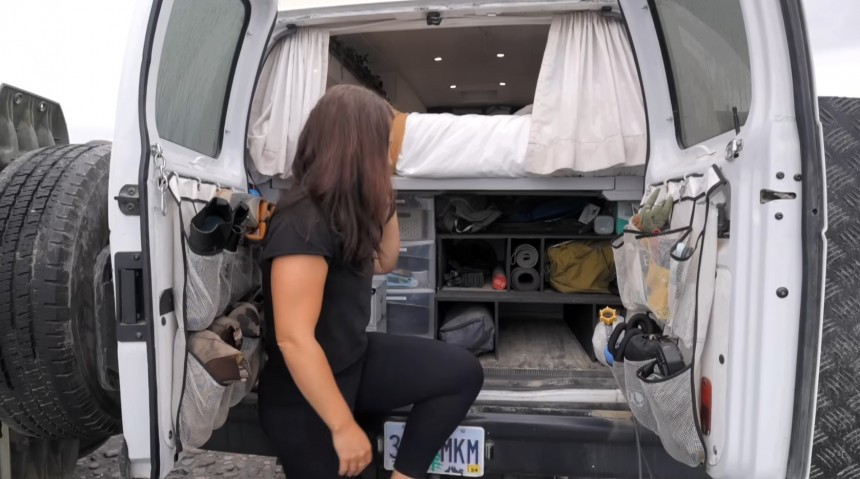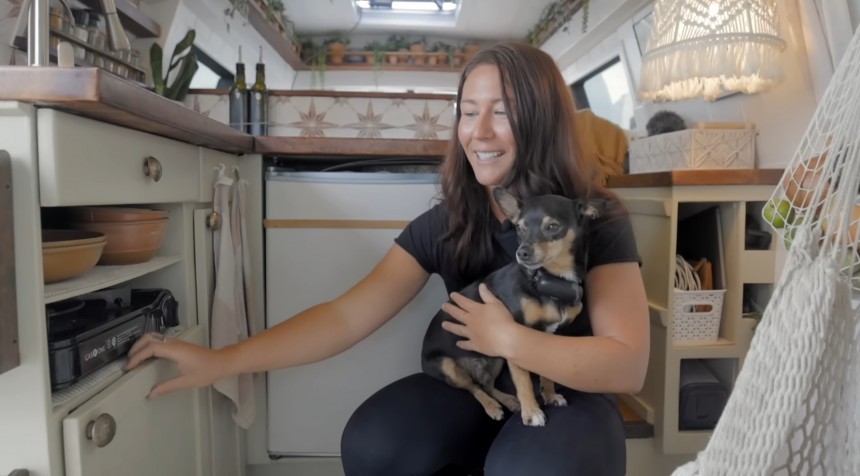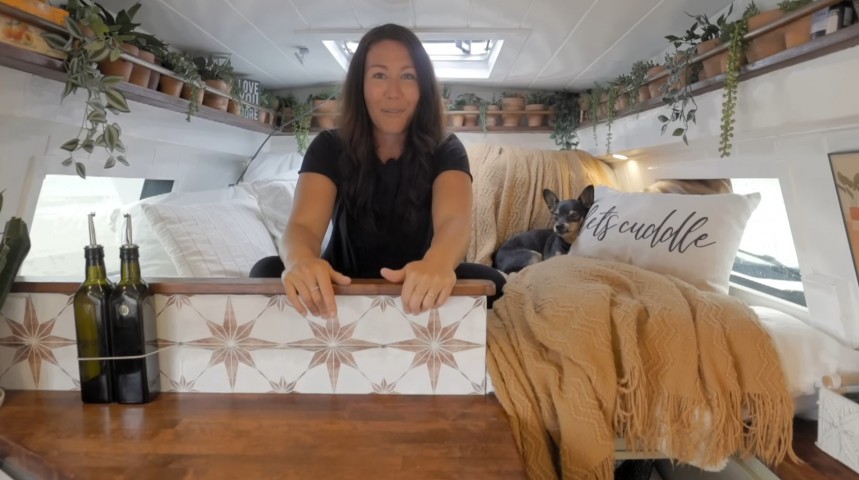With mobile homes being trendy at the moment, there's a myriad of builds available to check out for potential nomads and get an idea of what they need in their future traveling dwellings. But looking at what a person decided to change in a van conversion mobile home after spending a decent chunk of time on the road is one of the best ways to learn.
So, that's what we're going to take a look at today, as it showcases the decision process of figuring out what exactly is needed and what's just nice to have. Granted, this is just what one person came to find in two years of living the nomad life, so other people's mileage may vary, but it's still an excellent reference frame.
The build in question is based on a Ford E-350 passenger van, and it's suffered some changes over time, with the most crucial upgrade being improved security. Following a break-in, Brenda, the owner, decided to augment the van with a few safety features like motion sensors, alarms, and multiple redundant locks. And while this can sound a bit paranoid, safety is paramount when on the road.
The exterior of this van and utility-focused aspects are not the same either. The most apparent exterior changes done to the van include a lift kit, a storage box on the back, and an array of light bars, which all help this van conversion mobile home be more rugged, utilitarian, and off-road capable. But it's behind the rear doors, inside the garage, that a change with a significant impact has been made.
Brenda made a custom storage compartment to fit in the available space and has designated spots for every bit of gear that belongs in the garage. The doors are also well organized, with fabric pouches for shoes hanging from them, making things a lot easier to manage.
Inside, some things stayed the same, like the divider wall between the cabin and home section, which comes in handy both for increasing privacy and helping with insulation and preventing heat transfer. Still, some things changed, like adding multiple hookup points for the hammock, which is excellent for one of the best things about nomad life, relaxing and admiring the view.
There's also a desk implemented in this entrance area. Granted, it's just a wooden board that folds down and hangs in place using a chain. Even so, having a designated workspace is a good thing. It can improve productivity, especially when it even has a hidden monitor, so you don't have to struggle and squint into a small laptop screen.
But as a few features were added, some were given up in return, with the kitchen being the best example. It used to have a toaster oven, which is no longer present due to a high power draw that outweighed the benefits it brought.
The cassette toilet hidden inside one of the cupboards is gone as well, with the reasoning behind that choice being that there's always a place available on the road, and it was not worth the trouble and waste of space. Most of the shower equipment is also gone for the same reasons, and just a solar shower that can be used in the van was kept for going off-grid.
Still, there are a few more changes that happened in the kitchen, with an obvious one being a new backsplash and a fresh coat of paint that doesn't show every tiny speck of dust or fingerprint. And the fact that the most significant changes to happen here involve getting rid of equipment shows that when living on the road, there's no need for a fancy kitchen setup unless you really enjoy cooking complex meals.
That rings especially true when you consider how much electrical power, water, or propane, depending on the setup a highly equipped kitchen can use. And managing resources like the 30-gallon (113-liter) freshwater tank inside this mobile home is an essential aspect of van life, as there is a limit to what can be carried. Most people will only ever need a pantry, fridge, and stovetop, all present here, and great food can be made without fancy equipment.
The bedroom also pretty much stayed the same, except for adding a stepping board, which helps with the seating in this van, as there is not much of it available. Having a couple of different places where people can sit down can help tremendously if you decide to host guests, and attention should be paid to that, as meeting new people and interacting are a big part of the nomad lifestyle.
The last changes involve the technological and electrical aspects of this van. One part Brenda highly recommends is getting good and stable internet access, as most people have to work, even when living on the road. She opted for Starlink, a popular choice among nomads, as it works even in the most remote areas.
The final recommendation here related to the electrical setup inside the van, with this one having 320W of solar and a battery bank of 200Ah, which Brenda says is not enough for serious off-grid activities. As such, a more heavy-duty battery and solar array setup might be a better idea if there's room for it.
So, while this approach might not be a guide written in stone for most potential nomads, it serves as a great place to start. It can help people who haven't taken the step yet figure out what's really important when picking up van life and what they could potentially live without.
The build in question is based on a Ford E-350 passenger van, and it's suffered some changes over time, with the most crucial upgrade being improved security. Following a break-in, Brenda, the owner, decided to augment the van with a few safety features like motion sensors, alarms, and multiple redundant locks. And while this can sound a bit paranoid, safety is paramount when on the road.
The exterior of this van and utility-focused aspects are not the same either. The most apparent exterior changes done to the van include a lift kit, a storage box on the back, and an array of light bars, which all help this van conversion mobile home be more rugged, utilitarian, and off-road capable. But it's behind the rear doors, inside the garage, that a change with a significant impact has been made.
Brenda made a custom storage compartment to fit in the available space and has designated spots for every bit of gear that belongs in the garage. The doors are also well organized, with fabric pouches for shoes hanging from them, making things a lot easier to manage.
There's also a desk implemented in this entrance area. Granted, it's just a wooden board that folds down and hangs in place using a chain. Even so, having a designated workspace is a good thing. It can improve productivity, especially when it even has a hidden monitor, so you don't have to struggle and squint into a small laptop screen.
But as a few features were added, some were given up in return, with the kitchen being the best example. It used to have a toaster oven, which is no longer present due to a high power draw that outweighed the benefits it brought.
The cassette toilet hidden inside one of the cupboards is gone as well, with the reasoning behind that choice being that there's always a place available on the road, and it was not worth the trouble and waste of space. Most of the shower equipment is also gone for the same reasons, and just a solar shower that can be used in the van was kept for going off-grid.
That rings especially true when you consider how much electrical power, water, or propane, depending on the setup a highly equipped kitchen can use. And managing resources like the 30-gallon (113-liter) freshwater tank inside this mobile home is an essential aspect of van life, as there is a limit to what can be carried. Most people will only ever need a pantry, fridge, and stovetop, all present here, and great food can be made without fancy equipment.
The bedroom also pretty much stayed the same, except for adding a stepping board, which helps with the seating in this van, as there is not much of it available. Having a couple of different places where people can sit down can help tremendously if you decide to host guests, and attention should be paid to that, as meeting new people and interacting are a big part of the nomad lifestyle.
The last changes involve the technological and electrical aspects of this van. One part Brenda highly recommends is getting good and stable internet access, as most people have to work, even when living on the road. She opted for Starlink, a popular choice among nomads, as it works even in the most remote areas.
So, while this approach might not be a guide written in stone for most potential nomads, it serves as a great place to start. It can help people who haven't taken the step yet figure out what's really important when picking up van life and what they could potentially live without.


























